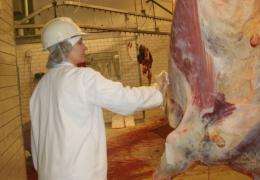Clean animals result in fewer E. coli

Sigrun J. Hauge has studied the effect of the measures implemented on farms and in slaughterhouses. The aim of the project "Uncontaminated Carcasses" was to uncover data that would help to improve the hygienic quality of meat from cattle and sheep by means of cleaner animals and efficient ways of slaughtering high-risk animals.
E. coli is a commonly occurring bacterium in the digestive tract of humans, animals and birds. Just a few strains are pathogenic and can cause diarrhea and kidney failure, particularly in children. The bacteria die at temperatures over 60-70 °C and are therefore normally eliminated by boiling and roasting. Hauge has shown that a new, rapid enzymatic method for detecting E. coli is equally as reliable as the traditional method of growing bacteria culture. This new method is therefore suitable for monitoring E. coli in abattoirs.
High-risk animals
Slaughterhouses have systems for categorising animals according to how dirty they are. Around 3-5% of the animals that arrive at abattoirs are so soiled that they are categorised as high-risk. Every year, deductions in the price of meat due to dirty animals amount to over 9 million Norwegian kroners. Soiled slaughter can pose a risk to food safety because faeces on hides/wool, intestines, knives and the hands of the butchers can be transferred to the meat during the slaughter process. Hauge studied the factors affecting the cleanliness of animals on farms and how clean or soiled hide affects the contamination of skinned carcasses. Her experiments confirmed that meat from dirty cattle has more E. coli than meat from clean cattle.
Sheep farmers are also subjected to price reductions for dirty and unshorn animals. Hauge's research showed that the surface of meat from shorn sheep has less E. coli than that of unshorn sheep immediately after skinning and that the point in time that the sheep are shorn before slaughtering is also significant when it comes to the amount of bacteria immediately after skinning. But towards the end of the slaughtering process, all the meat had equal amounts of E. coli on its surface, regardless of when the sheep were shorn.
Dirty and unshorn animals are considered a high risk. They are treated in separate product streams in the slaughterhouses and their meat is not used for raw products such as minced meat and cured meat, but for products that are heat treated before sale (such as sausages and meatballs etc.)
99.5% reduction of E. coli
Meat from lambs was hosed with water at 82 °C for 8 seconds in an enclosed "shower" - so-called hot water pasteurisation - before it was cooled. This treatment reduced the amount of E. coli on carcasses by 99.5%. After 5 days of cooling, no further E. coli were found on the meat. The recycled water in the shower was of a good microbiological, chemical and physical quality. Immediately after pasteurisation, the meat was rather pale, but it regained its normal colour after being cooled for 24 hours.
Hot water pasteurisation is not generally accepted as a hygiene measure in Norway and the EU and the Norwegian Food Safety Authority would have to give its approval, if the method is to be used at slaughterhouses. Hot water pasteurisation will obviate the need for separate product streams in abattoirs for high-risk sheep.
Cand.agric. Sigrun J. Hauge defended her doctoral research on 2nd May 2012 at The Norwegian School of Veterinary Science (NVH) with a thesis entitled “Hygienic impact of measures related to unclean cattle and sheep at farm level and in the abattoir”.














